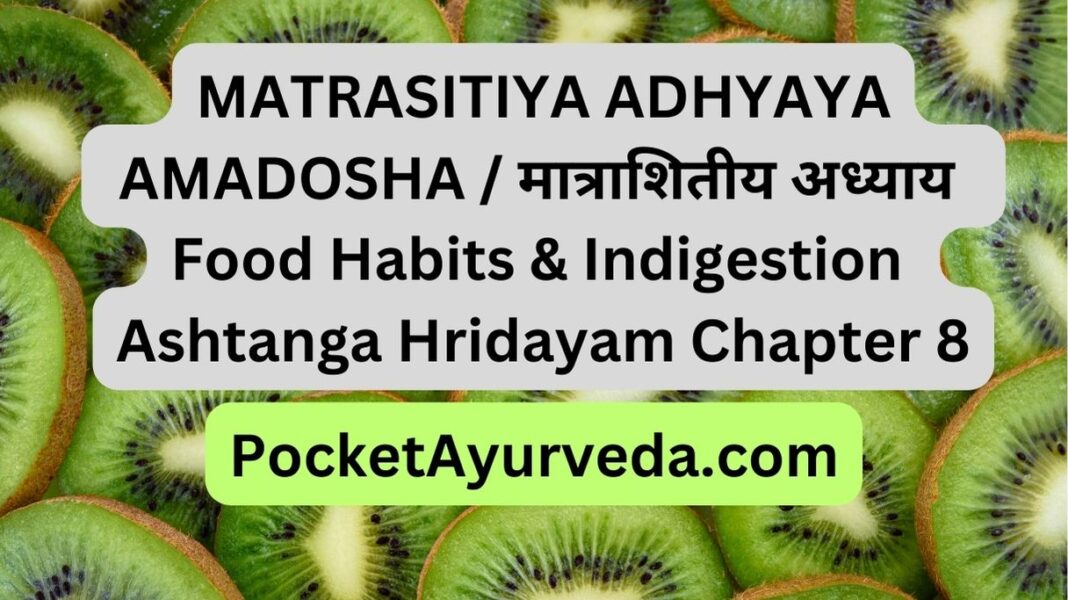Ashtanga Hridayam’s 8th chapter is known as Matrashiteeya Adhyaya. It covers the proper amount of food you should consume and the best time to eat food, different forms of indigestion and treatment, characteristics and types of drinks after, the correct technique of eating food, etc.
How much Food one should eat? AHARAMATRA APEKSHA
- the right portion of food the right amount is essential for food
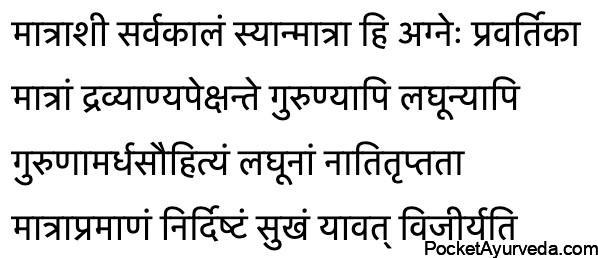

The proper amount of food to eat as per Ayurveda
The proper amount of food should activate the digestion power of Agni (which can be compared to fire in Ayurveda).
*foods that are light in digestion (laghu) and the ones that are difficult to digest (guru) both require a specific amount to ensure proper digestion.
BAD EFFECTS OF INSUFFICIENT AND EXCESS FOOD – HINATIMAATRA DOSAH
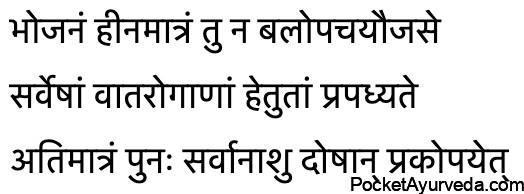

In general,
When the food is difficult to digest (such as oily foods such as sweets, non-veg, etc.),
- Consume until the half-satiation level is reached. (ardha sauhitya).
If the food is easy to take in, - It is recommended to consume it until one isn’t overly satisfied. (na ati truptata).
The right amount of food to consume is one it is digested easily.
Ritucharya adhyaya ऋतुचर्या Seasonal Regimen : Ashtanga Hridayam Chapter 3
EFFECT OF TAKING MORE OR LESS QUANTITY OF FOOD
A lower intake of food
Is not a way to boost strength,
Ojas (immunity) Diminished
The body cannot be properly nourished.
Over time, it can cause vata imbalance issues. a large amount of food is not recommended. It triggers the rapid growth of doshas.
EFFECTS OF OVEREATING
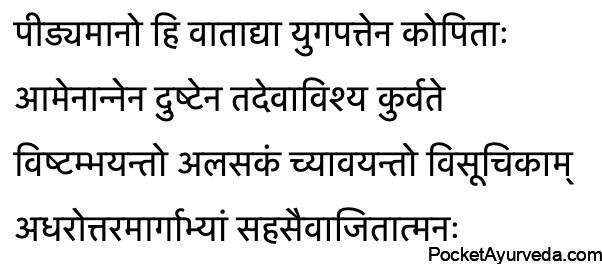

Because eating an excessive amount of food
vata, and doshas suddenly become more pronounced
and in association with undigested and vitiated foods (ama) and causing illnesses.
it triggers Alaska disease through the blocking of the flow of food through the alimentary tract, and
visuchika (gastroenteritis) by ejecting the undigested food particles in both downward as well as upward directions (diarrhea and nausea) simultaneously.
This is evident in people who are not self-controlled.
- and cannot manage their obsession with food.
ALASAKA – INDIGESTION and CONSTIPATION:


The food item that is not released through the upper route via vomiting
Down route through purgation.
And does not undergo digestion in the stomach.
It is stored in the stomach for a long time (=alasya).
- A disease that is a cause is known alasaka.
VISUCHIKA – GASTRO ENTERITIS


Result of the sudden increase of vata dosha in addition to other doshas
The patient feels an entire body of pain like being pinched by needles
Thus this condition is referred to as visuchika. (suchi means needle).
INFLUENCE OF DIFFERENT DOSHAS IN ALASAKA AND VISUCHIKA
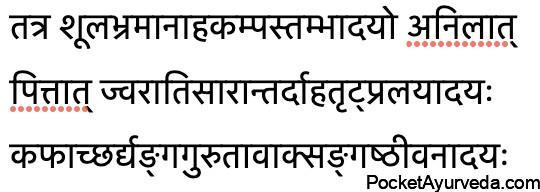

Then there is alasaka and visuchika
- If vata is affected this can cause
a. shoola – adominal pain
b. bhrama – delusion
c. anaha – bloating, fullness
d. kampa – tremors
e. stambha – stiffness etc symptoms. - If pitta gets irritated it can cause
a. jvara – fever
b. atisara – diarrhoea, dysentery
C. antaraha internal burning sensation
D. Trut – thirsty
e. pralaya – panic, unconsciousness
- If kapha is affected the result is
a. chardi – vomiting
B. anagaguruta – the weight of the body
C. vak sangha difficulty speaking
D. shteevana is excessive salivation. expectation and vomiting
MANIFESTATION OF ALASAKA SYMPTOMS:
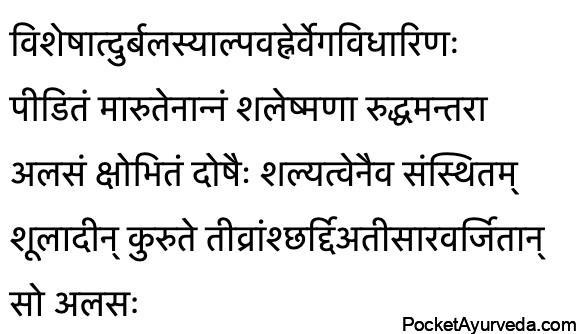

Alasaka is a common occurrence in
The weak,
Those who have weak digestion strength and
Who controls the desires of the body (Vega Dharana).
- Habitually. They are in them.
- Vata is increased
- It is associated with Kapha, which blocks the passage of undigested food through the digestive tract.
- It causes food to remain in the stomach as it is a foreign body.
- It causes abdominal colic as well as other signs,
- However, without vomiting or diarrhea.
DANDALASAKA
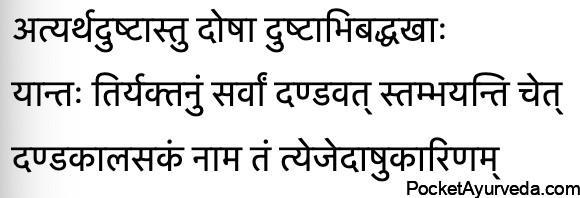

- Doshas with high levels of vitiation,
A. movement into vitiated and blocked channels through the accumulation of undigested food.
B. Thus, doshas become blocked throughout the GI tract,
C. and begin to flow in unnatural channels.
D. Doshas are then spread across the body and cause it to become stiff, like a log of wood.
- This is a disease known as dandakalasaka and must be ruled out for treatment since it can be fatal and can cause death.
AMA DOSHA
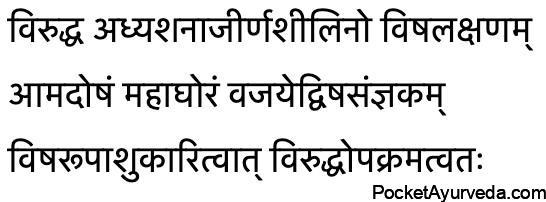

Those who engage in
- viruddha ashana – taking incompatible foods,
- adhyashana – consuming the excess food,
- Ajeerna ashana is eating food with indigestion,
- Initiates the amadosa dreadful that is very similar to poison.
- Therefore, it is known in the form of amavisha (undigested toxic food).
This type of person must be denied treatment due to,
A. because of its resemblance to poison,
B. rapidity in causing death.
C. The need for treatments that are of a different nature and their qualities.
TREATMENT OF ALASAKA
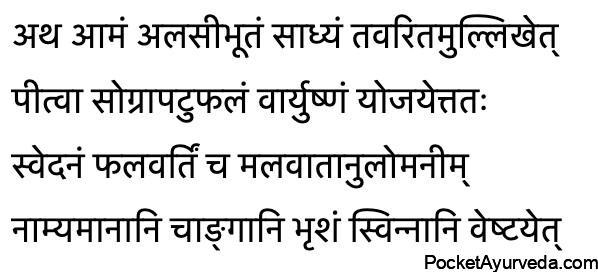

AMA – undigested food that has accumulated within the gastrointestinal tract should be removed promptly after determining the appropriate conditions for simple treatment.
- The person is required to drink warm water, mixed with the powder of
- ugra (vacha – acorus calamus),
- patu (saindhava – black salt) and
- Phala (madanaphala) can result in vomiting;
- The treatment is then followed by swedana (sudation treatment)
- Then, the phalavarti (rectal suppositories) made from fruit that assists in the movement downwards of flatus and feces should be administered.
The body parts that are not rigid ought to be well-fomented, and then covered with a cloth.
TREATMENT OF VISHUCHIKA


In advanced stages of visucika
- Branding with fire, especially over the heel is suggested.
- The patient must be instructed to fast that day as well as
- As the one who has been in purgation therapy.
- All post-virechana procedures and treatments should be provided for the individual patient.
AMADOSHA TREATMENT
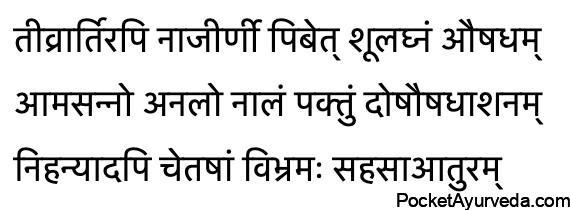

The patient with indigestion despite experiencing intense abdominal pain
- Do not consume medications to relieve pain;
- the agni digestive fire that is linked with ama. If ama is not processed properly, the metabolites won’t be able to digest doshas, foods, and drugs;
- The extreme problems resulting from these three issues will eventually cause death for the patient.


Once the food has been to be digested,
- If there is a feeling of heaviness and stiffness in the abdomen continues to persist,
- Then the medications must be administered to digest doshas residues and boost the agni digestion power.


Ama-related diseases are caused by undigested food,
- are alleviated by apatarpana (non-nourishment);
Three types of apatarpana suitable with the 3 doshas must be considered with a careful review of each aspect.


If ama is small, Only langhana (fasting) is acceptable,
If it’s moderate Langhana (fasting), as well as pachana digestion drugs, are required;
If it’s serious, Shodhana (purification of the panchakarma treatment) is required, since it will remove ama and dosha at the source.
TREATMENT PRINCIPLE FOR DISEASES
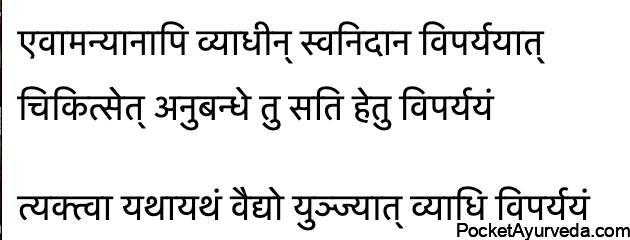

All other illnesses are best treated with methods that are opposite to the underlying causes. It is known as viparyaya Chikitsa.
Hetu means causative factors.
If however, the disease recurs or continues for a long period, then viparyaya hetu should be given up and treatment specific to the disease should be implemented. It is known as vyadhi viparyaya Chikitsa.


Tadarthakari Chikitsa (Therapies that, while are not in fact opposite to the disease or its cause, still achieve the desired outcome) must be used;
- Once doshas are back to normal
- When the ama is completely relaxed,
- after digestion activity has fully restored,
(a) then oil-bath
B) taking oil (oleation treatments) and
C) treatment with enema, etc.
Should be given to provide the patient strength.
AJIRNA BHEDA – DIFFERENT TYPES OF INDIGESTION


The vitiation of kapha can cause “ama ajeerna“
It is distinguished by
A. an increase in the eye cheeks and sockets
B. belching, similar to the kind that occurs shortly after eating,
C. excessive salivation
D. nausea and
E. heaviness on the body.
VISHTHABDHA AJIRNA


Indigestion of this kind is the result of vitiated vata
is distinguished by
A. abdominal pain,
b. constipation,
C. flatulence and
d. debility.
VIDAGDHA AJIRNA


Indigestion of this kind is caused by pitta vitiated
and also has
a. thirst,
b. fainting,
c. dizziness,
d. giddiness,
E. the sour belching, and
F. burning sensations as signs.
AJIRNA CIKITSA – TREATMENT OF INDIGESTION


- Ama ajirna is the name of the ama. (Kapha)
*Langhana-fasting should be observed;
- for vishtabdha ajirna, (Vata)
- Swedana (sudation therapy) should be used;
- for vidagdha ajirna, (Pitta)
- Vamana (emesis therapy) is recommended or any other treatment that is suitable in relation to stage illness can be performed.
VILAMBIKA


Vilambika – another type of digestion
- Result of the massive accumulation of ama within the channels.
- It’s by vata and kapha vitiation.
- and exhibits all the signs of ama;
- Its treatment is like the ama.
RASASHESHA AJEERNA is a different kind of digestion
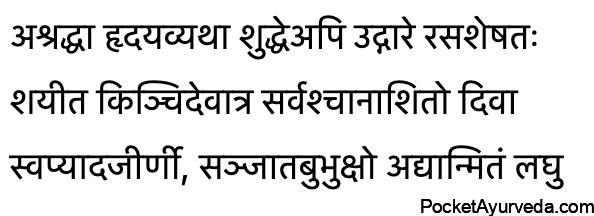

Rasashesha ajeerna –
A. lack of enthusiasm
B. irritation in the area of the heart despite belching
are Rasashesha’s characteristics. Ajrna, a different kind of indigestion.
A person who is like this must sleep in the daytime, but not eat any food.
AJIRNA SAMANYA LAKSHANA – GENERAL SYMPTOMS OF INDIGESTION


A. constipation or diarrhea,
b. exhaustion,
C. Vata’s inactivity
D. dilation of the abdomen,
E. sensation of weightiness
F. as well as dizziness, are common symptoms associated with the symptom ajirna (indigestion).
AJIRNA ANYAKARANANI – OTHER CAUSES OF INDIGESTION
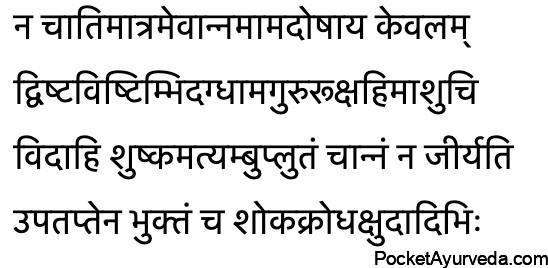

Consuming a large amount of food isn’t the only reason behind the ama dosha’s production.
- Foods that are deemed to be undesirable,
- causes flatulence.
- which are either overcooked or are not cooked.
- that aren’t easy to digest,
- which are dry,
- Very cold,
- filthy (contaminated),
- causes burning sensations during digestion
- that are then dried or soaked in water,
- Do not go through the proper digestion process;
- as well as the food that is consumed by those who suffer from
a. grief,
b. anger,
c. excess hunger etc.
BAD FOOD HABITS – DUSHTA ASHANA
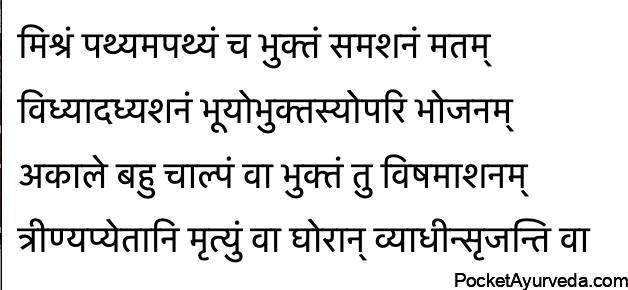

- Consuming food that is suitable and not combined is known as samashana.
- Consuming a large amount of food after the meal has been taken is adhyasana.
- Drinking less, or the same at the wrong time is vishamashana,
All three result in death or deadly diseases.
AHARA VIDHI – REGIMEN OF DIET
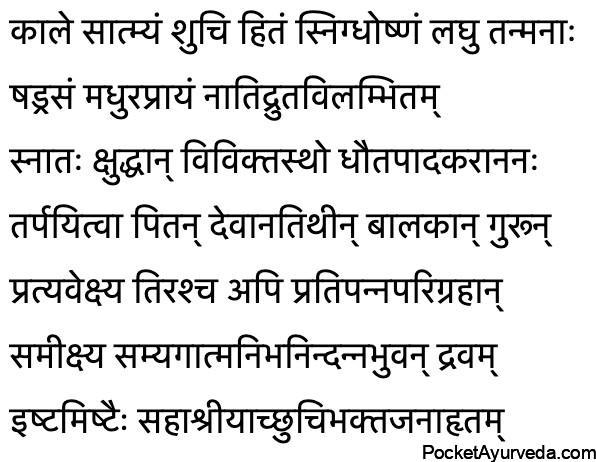

- Kale satmyam – food is best consumed at the right time,
- Shuchi hitam is recommended to use the most accustomed and healthy, clean, appropriate to health,
- Snigdha, ushna the laghu, which is hot, unctuous, and light, easy to digest;
- Tamanmanaa means eating with attention to detail
- Shadrasa, and Madhurapraayam should include all six tastes and have a predominantly sweet taste.
- Na atidruta, Vilambitam is not consumed very fast or very slowly;
- Snataha – After a bath,
- kshut vaan – After having good hunger,
- viviktastha – sitting alone,
- Dhauta pada, kara aananaha after washing feet as well as hands and face.
- tarpayitva pitrun, devan balakaan, atitheen garoon, pitrus (manes) gods guests, children, guests, and the guru.
- after satisfying all household’s dependents (such as horses, servants, and other animals who require services, parrots, and other pets, etc. ),
- After carefully examining your own personal constitution, preferences, and dislikes
- Without scolding or abusing the food items,
- Without too much talking;
- You should eat more liquid food items,
- the thing that is loved,
- In the company of your favorite individuals and
- The people who serve him are clean and loyal to him.
Ritucharya adhyaya ऋतुचर्या Seasonal Regimen : Ashtanga Hridayam Chapter 3


- which has been contaminated with hairs, grasses, etc.
- re-heated, which is made up of vegetables and
- unsuitable grains,
- that is extremely hot and very salty must be resisted.
right time,healthy, clean, hot, unctuous, and light, easy to digest; eating with attention, all six tastes predominantly sweet taste. should not consumed very fast or very slowly;sitting alone,After a bath it should be consumed After having good hunger, after washing feet as well as hands and face, more liquid food items, the thing that is loved,company of your favorite individuals and The people who serve him are clean and loyal to him. contaminated with hairs, grasses, re-heated, which is made up of vegetables and unsuitable grains, that is extremely hot and very salty must be resisted.
FOOD THAT SHOULD NOT BE CONSUMED HABITUALLY – Daily Repeatedly
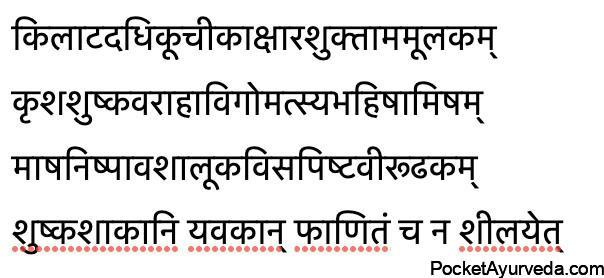

- Kilata (the dairy product that is sweet in flavor),
- dadhi – curds,
- Kuchika (solid component from curds),
- kshara (alkalies),
- Sukta (fermented greek),
- ama mulaka – uncooked radish,
- the flesh of animals that are malnourished,
- meat that is dry,
- The meat from the
a. boar,
b. sheep,
c. cow,
D. fish and
e. buffalo, - masha (black gram),
- nishpava;
- saluka,
- bisa,
- pista (powdery and starchy),
- germinated grains
- dried vegetables,
- Yavaka (small grain of barley),
- Phantita (half cooked Molasses that has been cooked half) They should not be consumed frequently.
PATHYA AHARA – FOOD THAT CAN BE CONSUMED HABITUALLY (ON DAILY BASIS, FOR A LONG TIME)
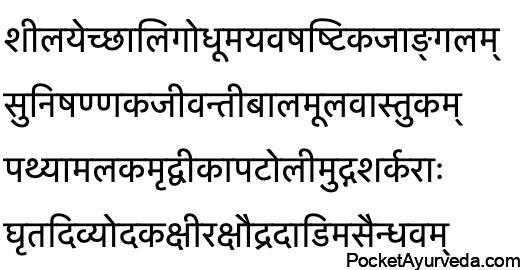

- Shali (rice),
- Godhuma (wheat),
- yava – barley – hordeum vulgare,
- Shaschtika – Shashtishaali (rice maturing over sixty days),
- Jangala (meat of animals that live in desert-like lands),
- sunisannaka,
- jivanti – leptadenia reticulata,
- balamulaka (young radish),
- pathya (haritaki)
- amalaka (amla – indian gooseberry),
- Mridwika dry grapes
- Patola-pointed gourd
- mudga – green gram,
- sarkara (sugar),
- ghrita (ghee),
- Diviyodaka (rain the water of pure or purified water),
- ksheera (milk),
- Kshoudra (honey),
- dadima – pomegranate – punica granatum
- and saindhava, the rock salt (salt) is a food item that can be consumed regularly.


- Triphala, honey, and ghee must be consumed every night to improve eyesight.
- any other things which are good for promoting/maintaining health and dispelling diseases can also be consumed habitually.
FOOD THAT SHOULD BE CONSUMED AT THE BEGINNING OF A MEAL
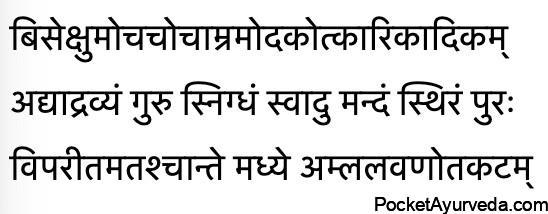

Foods
- That they are not easy to digest (Heavy to digest),
- that are not fat,
- sweet,
- Hard and slow like
- bisa,
- ikshu (sugarcane),
- mocha,
- coca,
- Amra (mango),
- modaka (sweet meat ball),
- Utkarika (sweet dish) and others. Should be consumed prior to the start of the course.
- Foods of different quality, are to be eaten at end of the meal.
- Mainly salt and sour, usually at the center of the meal.


stomach food parts as per ayurveda as food intake
- Two parts in the stomach (half of the capacity) (50%) should be filled with food that is solid,
- One part is made up of liquids (25%) and
- The remaining part should be left unoccupied (25%) to accommodate air and other airborne particles.
ANUPANA – AFTER – DRINK
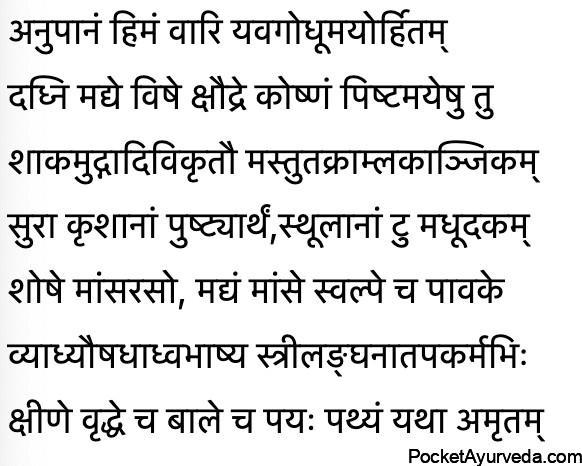

- Cold water is the perfect after-drink (anupana)
- Following meals that prepared from
- yava (barley) and
- godhuma, wheat
- following the consumption of dadhi curds, yoghurt or curds
- wine,
- poison and
- Honey
- Warm water is the ideal after-drink drink for
food items that are
- starchy,
- Mastu – supernatant curds’ liquid (whey),
- Takra (diluted buttermilk)
- amla kanjika (fermented gruel);
- meals made from vegetables, Mudga (green gram) as well as other legumes:
- Sura (beer) It is a perfect post-dinner drink for the slim person.
- Honey and water mixture is the perfect drink to have after a workout for the overweight.
- The meat soup is a great after drinking for the weak,
- The wines are perfect for an aperitif
- a meal consisting of meat and
- for those with an insufficient digestive capacity
Milk is best used as a nector to those
- who are affected due to illness, medication (and treatments),
- walking long distances,
- speaking,
- sexual interaction,
- fasting,
- exposure to sunlight
- and various other exhausting tasks;
- for those who are emaciated.
- The elderly,
- as well as children.
AN IDEAL ANUPANA – AFTER-DRINK


- is the term used to describe a food item that has properties that are different from those of the food items, but is not incompatible with them; anupana drink is always beneficial.
ANUPANA BENEFITS- AFTER – DRINK


- invigorates,
- provides contentment
- aids in proper movement of food,
- Stability of the body components;
- Letting go of hard masses of food
- Their proper liquidification (moistening) as well as digestion.
CONTRAINDICATION FOR ANUPANA


It’s not a good idea to do it.
- disorders of the organs that are above the shoulders (ear and throat, nose eyes, and brain related disorders),
- dyspnoea (copd asthma),
- cough,
- Injury to the the chest (lungs),
- rhinitis,
- for those who are involved in speaking or singing, and
- with hoarseness of voice.


Drinking liquids
is recommended to avoid the ones
A. people who are dehydrated,
B. those suffering from polyuria
C. conditions of the eyes and throat
D. or injuries (ulcers).


After drinks regimen
All people – healthy and sick, should avoid speaking, taking long walks and resting immediately after drinking drinks; exposure to sunlight and fire, driving vehicles, or swimming, and riding on animals immediately after eating food.
AHARA KALA – PROPER TIME OF MEALS
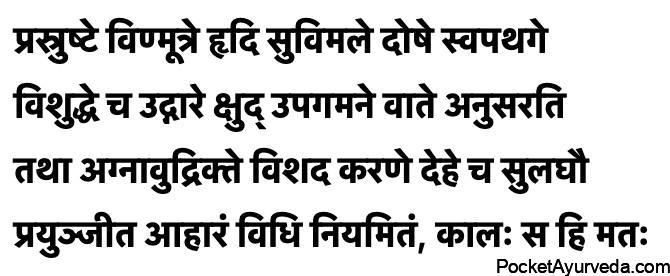

The ideal time to take meals is
*after the elimination of urine and feces,
When the mind has been declared pure (devoid of any emotions),
*When the Doshas are on their natural pathways (functioning in a normal way),
*when the belching is pure, with no scent or taste
*When hunger is evident,
When the flatus appears to be moving easily downwards,
*when the activity of digestion is intense,
*when the sense organs have operating in a clear manner,
*when the body isn’t heavy
Foods should be eaten in accordance with the rules and guidelines for eating.
FAQ’s for Matrashitiya adhyaya – AMAVATA
- How much Food one should eat?
Consume foodx until the half-satiation level is reached. (ardha sauhitya).
- How our stomach should be filled with food?
Two parts in the stomach (half of the capacity) (50%) should be filled with food that is solid, One part is made up of liquids (25%) and The remaining part should be left unoccupied (25%) to accommodate air and other airborne particles.
- what are the EFFECT OF TAKING MORE OR LESS QUANTITY OF FOOD?
Is not a way to boost strength,
Ojas (immunity) Diminished
The body cannot be properly nourished.
Over time, it can cause vata imbalance issues. a large amount of food is not recommended. It triggers the rapid growth of doshas. - what are the EFFECTS OF OVEREATING?
Because eating an excessive amount of food
vata, and doshas suddenly become more pronounced
and in association with undigested and vitiated foods (ama) and causing illnesses. - what is alasaka?
food is stored in the stomach for a long time (=alasya) and does not undergo digestion.
- what is visuchika?
The patient feels an entire body of pain like being pinched by needles
Thus this condition is referred to as visuchika. (suchi means needle), sudden increase of vata dosha. - what is DANDALASAKA?
Doshas with high levels of vitiation, movement into vitiated and blocked channels through the accumulation of undigested food, Thus, doshas become blocked throughout the GI tract, and begin to flow in unnatural channels. Doshas are then spread across the body and cause it to become stiff, like a log of wood.
- why ama is formed in the body?
viruddha ashana – taking incompatible foods, adhyashana – consuming the excess food, Ajeerna ashana is eating food with indigestion, Initiates the amadosa dreadful that is very similar to poison. Therefore, it is known in the form of amavisha (undigested toxic food).
- is ama dosha fatal?
This type of person must be denied treatment due to,
A. because of its resemblance to poison,
B. rapidity in causing death.
C. The need for treatments that are of a different nature and their qualities. - what is the treatment of alasaka?
The person is required to drink warm water, mixed with the powder of
ugra (vacha – acorus calamus),
patu (saindhava – black salt) and
Phala (madanaphala) can result in vomiting;
The treatment is then followed by swedana (sudation treatment)
Then, the phalavarti (rectal suppositories) made from fruit that assists in the movement downwards of flatus and feces should be administered.
The body parts that are not rigid ought to be well-fomented, and then covered with a cloth. - what is the treatment for visuchika?
The person is required to drink warm water, mixed with the powder of
ugra (vacha – acorus calamus),
patu (saindhava – black salt) and
Phala (madanaphala) can result in vomiting;
The treatment is then followed by swedana (sudation treatment)
Then, the phalavarti (rectal suppositories) made from fruit that assists in the movement downwards of flatus and feces should be administered.
The body parts that are not rigid ought to be well-fomented, and then covered with a cloth. - what is the treatent of amadosha?
Do not consume medications to relieve pain, the agni digestive fire that is linked with ama. If ama is not processed properly, the metabolites won’t be able to digest doshas, foods, and drugs;digest doshas residues and boost the agni digestion power. apatarpana (non-nourishment); If ama is small, Only langhana (fasting), If moderate Langhana (fasting), as well as pachana digestion drugs, If serious, Shodhana (purification of the panchakarma treatment)
- ama ajeerna is caused by?
kapha dosha
- vishthabdha ajirna is caused by?
vata dosha
- vidagdha ajirna is caused by which dosha?
pitta dosha
- what are the types of ajirna?
ama ajeerna, vidagdha ajirna, vishtabdha ajirna
- what are the treatment of different types of indigestion?
Ama ajirna is the name of the ama. (Kapha)
*Langhana-fasting should be observed;
for vishtabdha ajirna, (Vata)
Swedana (sudation therapy) should be used;
for vidagdha ajirna, (Pitta) - what is rasashesha ajeerna?
A. lack of enthusiasm
B. irritation in the area of the heart despite belching
are Rasashesha’s characteristics. Ajrna, a different kind of indigestion. - line of treatment in amadosa
Indigestion sufferers of any kind should rest all day long without taking food.
Later, in the event that he is hungry, it is recommended to eat a small amount of food that is easily digestible. - what are the GENERAL SYMPTOMS OF INDIGESTION?
A. constipation or diarrhea,
b. exhaustion,
C. Vata’s inactivity
D. dilation of the abdomen,
E. sensation of weightiness
F. as well as dizziness, are common symptoms associated with the symptom ajirna (indigestion). - which are bad food habits?
Consuming food that is suitable and not combined is known as samashana.
Consuming a large amount of food after the meal has been taken is adhyasana.
Drinking less, or the same at the wrong time is vishamashana, - WHAT REGIMEN SHOULD BE FOLLOWED FOR DIET?
right time,healthy, clean, hot, unctuous, and light, easy to digest; eating with attention, all six tastes predominantly sweet taste. should not consumed very fast or very slowly;sitting alone,After a bath it should be consumed After having good hunger, after washing feet as well as hands and face, more liquid food items, the thing that is loved,company of your favorite individuals and The people who serve him are clean and loyal to him. contaminated with hairs, grasses, re-heated, which is made up of vegetables and unsuitable grains, that is extremely hot and very salty must be resisted.
- FOOD THAT SHOULD NOT BE CONSUMED Daily?
Kilata (the dairy product that is sweet in flavor),
dadhi – curds,
Kuchika (solid component from curds),
kshara (alkalies),
Sukta (fermented greek),
ama mulaka – uncooked radish,
the flesh of animals that are malnourished,
meat that is dry,
The meat from the
a. boar,
b. sheep,
c. cow,
D. fish and
e. buffalo,
masha (black gram),
nishpava;
saluka,
bisa,
pista (powdery and starchy),
germinated grains
dried vegetables,
Yavaka (small grain of barley),
Phantita (half cooked Molasses that has been cooked half) They should not be consumed frequently. - which FOOD CAN BE CONSUMED daily?
Shali (rice),
Godhuma (wheat),
yava – barley – hordeum vulgare,
Shaschtika – Shashtishaali (rice maturing over sixty days),
Jangala (meat of animals that live in desert-like lands),
sunisannaka,
jivanti – leptadenia reticulata,
balamulaka (young radish),
pathya (haritaki)
amalaka (amla – indian gooseberry),
Mridwika dry grapes
Patola-pointed gourd
mudga – green gram,
sarkara (sugar),
ghrita (ghee),
Diviyodaka (rain the water of pure or purified water),
ksheera (milk),
Kshoudra (honey),
dadima – pomegranate – punica granatum
and saindhava, the rock salt (salt) is a food item that can be consumed regularly. - how to improve eyesight as per ayurveda?
Triphala, honey, and ghee must be consumed every night to improve eyesight.
- which FOOD SHOULD BE CONSUMED AT THE BEGINNING OF A MEAL
not easy to digest (Heavy to digest),that are not fat,sweet,Hard and slow like bisa,ikshu (sugarcane), mocha,coca, Amra (mango),modaka (sweet meat ball),
Utkarika (sweet dish) and others. Should be consumed prior to the start of the course.


